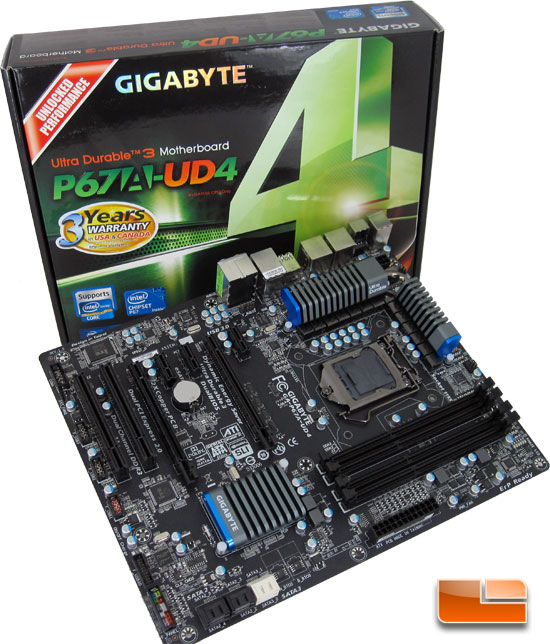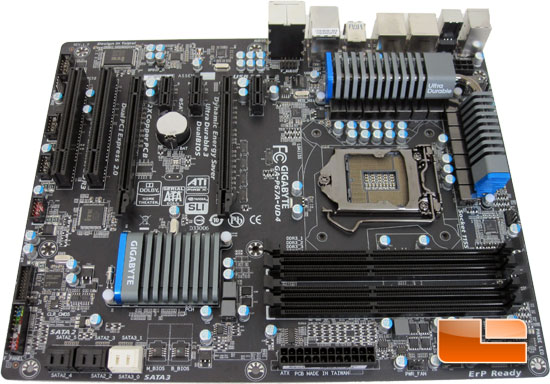GIGABYTE P67A-UD4 Motherboard Performance Review
Final Thoughts and Conclusion

When looking at the GIGABYTE P67 “Sandy Bridge” line up we see that there is a decent price difference between a board like the Flagship P67A-UD7 and the P67A-UD4 that we have been looking at today. One has to ask, what makes the P67A-UD7 worth that much more than our P67A-UD4? I know that when I am building a system, I am concerned about getting the most bang for my buck. With that being said, let’s take a look at some of the differences between the flagship P67A-UD7 and the mainstream P67A-UD4.
One of the first differences we come across between the Flagship P67A-UD7 and the P67A-UD4 that we are taking a look at today is the audio codec that is used. The UD7 uses a Realtek ALC 889, while our P67A-UD4 uses a Realtek ALC892 HD Codec. Another notable difference is the LAN capabilities. The P67A-UD7 and the P67A-UD4 use the Realtek RTL8111E Gigabit LAN controller. The difference between the boards is the UD7 has a pair of the Realtek RTL8111E chips and supports teaming and Smart Dual LAN. Another significant difference is the number of PCIe X16 slots. Our GIGABYTE P67A-UD4 has a pair that run x8 if both slots are populated and x16 on the first slot if running a single card. The UD7 features four PCIe x16 slots, two of which run at x16 and two that run at x8. For most of us we will see minimal, if any, benefits from the increased bandwidth on the P67A-UD7. Both boards support NVIDIA SLI technology and AMD CrossFireX, though the UD7 will support 3 way as well. Another defining difference between the two boards is the storage capabilities. Both boards feature SATA 6Gbps from the Intel P67 chipset and a Marvell 88SE9128 for eSATA. The P67A-UD7 has a second Marvell chip which provides a second pair of SATA 6Gbps ports. All of the above differences drive up the price of the P67A-UD7, leaving them out gives us a board that has the features most mainstream users will need at a price that won’t drain the wallet.

When it comes down to it, the overall performance of the GIGABYTE P67A-UD4 has been spot on with the other Intel P67 systems that we have toyed with. In fact, performance in areas such as USB 3.0 and SATA6 performance were at or near the top spot. When it comes down to it, factors other than performance can and do affect purchasing decisions. One of these factors is price. The GIGABYTE P67A-UD4 comes to us with a suggested retail price of $189.00. Once these boards are re-released with the new B3 stepping chipsets which will correct the Cougar Point SATA Bug, I don’t doubt that we will be able to find the GIGABYTE P67A-UD4 with a lower street price. Though that remains to be seen. Another factor is the warranty that accompanies your purchase. The GIGABYTE P67A-UD4 is backed by a three year warranty from the date of manufacturing. The idea of using the date of manufacture is both good and bad in my eyes. On one hand, you don’t have to worry about registering the product since the date won’t change. On the other hand, once the Intel P67 systems have been around for a while, it is possible that you may get a board that has been sitting on the shelves for a time. This reduces the warranty period for the end user. If you happen to go through systems like I do that won’t be an issue since you want the latest and greatest!
As much as I am pleased with the GIGABYTE P67A-UD4, I will admit to one aspect that I’m not wild about. The fact that GIGABYTE is one of the big three enthusiast boards out there today, I was quite surprised the first time I fired up the P67A-UD4. I can honestly say that I expected to find UEFI (Unified Extensible Firmware Interface) BIOS. ASUS uses UEFI on the P8P67 series and MSI uses it on the Questions or comments? View this thread in our forums!

Comments are closed.